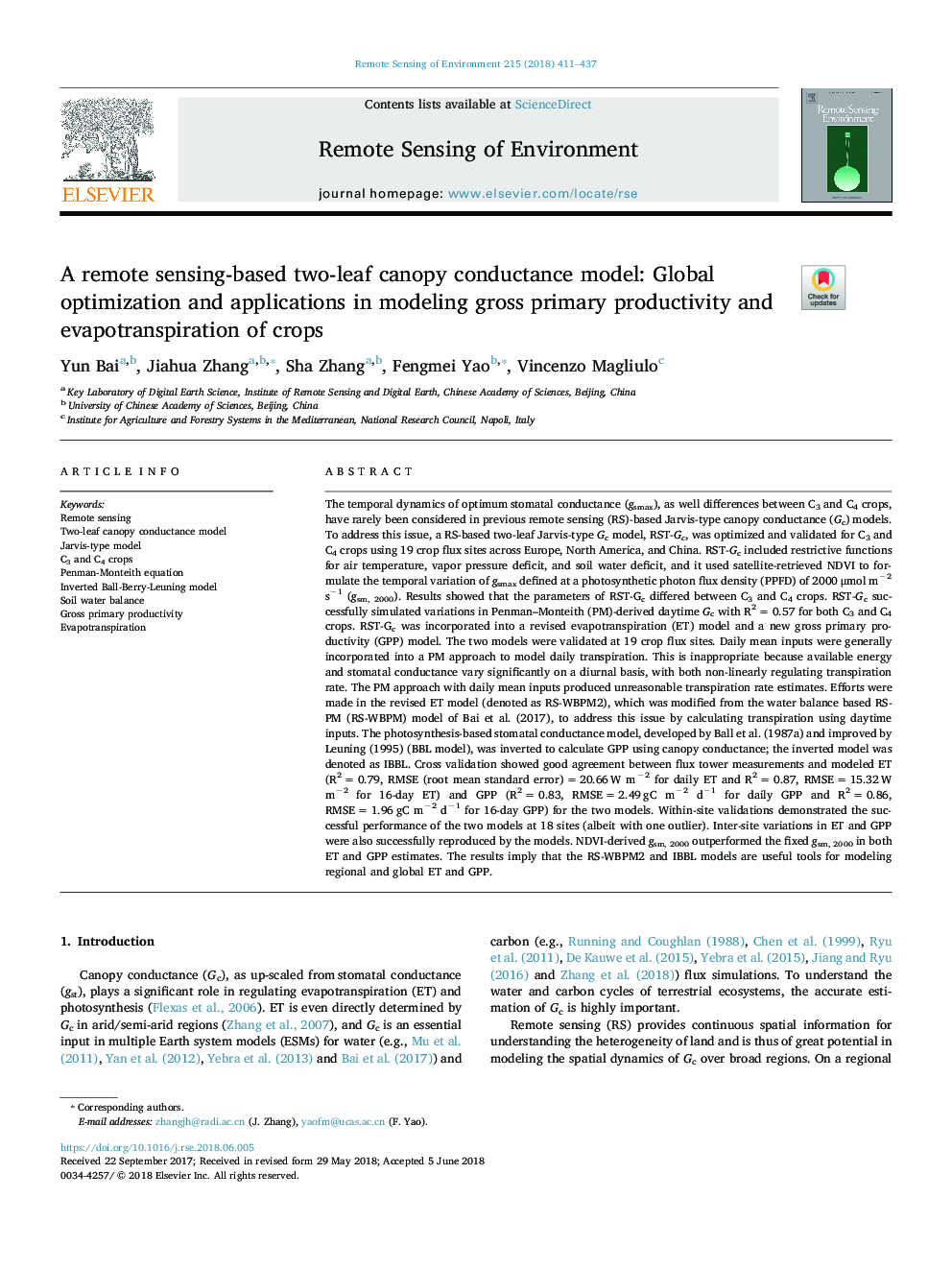| Article ID | Journal | Published Year | Pages | File Type |
|---|---|---|---|---|
| 8866485 | Remote Sensing of Environment | 2018 | 27 Pages |
Abstract
The temporal dynamics of optimumâ¯stomatal conductance (gsmax), as well differences between C3 and C4 crops, have rarely been considered in previous remote sensing (RS)-based Jarvis-type canopy conductance (Gc) models. To address this issue, a RS-based two-leaf Jarvis-type Gc model, RST-Gc, was optimized and validated for C3 and C4 crops using 19 crop flux sites across Europe, North America, and China. RST-Gc included restrictive functions for air temperature, vapor pressure deficit, and soil water deficit, and it used satellite-retrieved NDVI to formulate the temporal variation of gsmax defined at a photosynthetic photon flux density (PPFD) of 2000â¯Î¼mol mâ2 sâ1 (gsm, 2000). Results showed that the parameters of RST-Gc differed between C3 and C4 crops. RST-Gc successfully simulated variations in Penman-Monteith (PM)-derived daytime Gc with R2â¯=â¯0.57 for both C3 and C4 crops. RST-Gc was incorporated into a revised evapotranspiration (ET) model and a new gross primary productivity (GPP) model. The two models were validated at 19 crop flux sites. Daily mean inputs were generally incorporated into a PM approach to model daily transpiration. This is inappropriate because available energy and stomatal conductance vary significantly on a diurnal basis, with both non-linearly regulating transpiration rate. The PM approach with daily mean inputs produced unreasonable transpiration rate estimates. Efforts were made in the revised ET model (denoted as RS-WBPM2), which wasâ¯modified from the water balance based RS-PM (RS-WBPM) model of Bai et al. (2017), to address this issue by calculating transpiration using daytime inputs. The photosynthesis-based stomatal conductance model, developed by Ball et al. (1987a) and improved by Leuning (1995) (BBL model), was inverted to calculate GPP using canopy conductance; the inverted model was denoted as IBBL. Cross validation showed good agreement between flux tower measurements and modeled ET (R2â¯=â¯0.79, RMSE (root mean standard error)â¯=â¯20.66â¯W mâ2 for daily ET and R2â¯=â¯0.87, RMSEâ¯=â¯15.32â¯W mâ2 for 16-day ET) and GPP (R2â¯=â¯0.83, RMSEâ¯=â¯2.49â¯gC mâ2 dâ1 for daily GPP and R2â¯=â¯0.86, RMSEâ¯=â¯1.96â¯gC mâ2 dâ1 for 16-day GPP) for the two models. Within-site validations demonstrated the successful performance of the two models at 18 sites (albeit with one outlier). Inter-site variations in ET and GPP were also successfully reproduced by the models. NDVI-derived gsm, 2000 outperformed the fixed gsm, 2000 in both ET and GPP estimates. The results imply that the RS-WBPM2 and IBBL models are useful tools for modeling regional and global ET and GPP.
Keywords
Related Topics
Physical Sciences and Engineering
Earth and Planetary Sciences
Computers in Earth Sciences
Authors
Yun Bai, Jiahua Zhang, Sha Zhang, Fengmei Yao, Vincenzo Magliulo,
